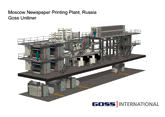Newspaper & Mailroom
Moscow Newspaper Printing Plant (MNPP), Russia, to install highly versatile Goss press system

Wednesday 29. October 2008 - Combined Uniliner and Universal configuration will include heatset and coldset capabilities and extensive automation features Single-width and double-width towers will produce broadsheet, tabloid and magazine formats
A unique new Goss press system scheduled for installation by the Moscow Newspaper Printing Plant (MNPP) early next year will further expand the versatility of combined newspaper and commercial printing capabilities.
MNPP has invested in a combined Goss Uniliner and Universal press for the production of a wide range of coldset, heatset or combined heatset /coldset products. The technical and technological support of the project was arranged by NISSA Mediaproject – the official agent of Goss International for newspaper equipment in Russia and CIS.
The new press system, with two double-width towers, one single-width tower, two folders and a Goss Ecocool dryer, will be capable of operating as a combined press using either of the two folders, or as two separate presses. MNPP’s chosen solution will provide greater flexibility and the highest quality to enable the plant to print in 100 percent color for the first time.
Yuri Yakovlev, general director at MNPP, explains, “Competition to win print contracts is tough. Publishers and advertisers alike are demanding full color and the highest quality print in order to maintain readership from today’s consumers. By investing in Goss technology and specifying many automation features, we will have a very flexible and attractive solution to suit the needs of almost any customer.”
MNPP specializes in newspaper production but also prints a number of magazines. Titles currently produced at the facility include MK, one of Russia’s biggest newspapers, Moscow Pravda, Sport Express, Petrovka 38 and Novaya Gazeta.
“There is a growing demand for manufacturers to engineer presses with more and more automation features in order to achieve almost perfect quality,” explains Yakovlev. “Reducing start-up waste, manpower, and operator error all make the cost of ownership less expensive.”
The new press system will feature a 578 mm cut-off. The two double-width Uniliner towers will accommodate variable web widths from 1320 to 1680 mm, while the 2×2 single-width Universal tower will accommodate web widths of up to 914 mm. The 2:5:5 and 2:3:3 jaw folders will produce broadsheet and tabloid newspapers and will include push-button changeover capabilities. The 2:3:3 folder will also produce up to 32-page A4 quarterfolded magazine products in full color.
Yakovlev comments, “We saw the full potential of our investment when Goss International organized a demonstration of a new Uniliner press at an installation in France. We were pleased and very impressed to witness the press running at 75,000 copies per hour using Russian newspaper print reels. This was the only test of this type we could arrange with Russian paper and, because of the differences between that and European paper, we were delighted to see the press running at full speed. Goss International and Nissa rose to the challenge, so we had no doubts about our choice of partners for the future.”
A Goss Ecocool dryer will include integrated chill rolls and advanced heat exchange technology to reduce energy requirements. Yakovlev comments, “Almost every business is now working on lowering their energy consumption. In this industry, companies that do so can significantly reduce their impact on the environment whilst increasing profitability.”
The new Goss press at MNPP will also include a number of automation features to streamline production, decrease costs, and improve uptime and the delivery time for all publications. Each Uniliner and Universal printing unit will be equipped for automated presetting, semi-automatic plate loading for faster job changeovers, and automatic web lead and guiding.
Yakovlev confirms, “Once the installation is complete we will be able to print in 100 percent color for the first time, which will certainly be attractive for our existing and potential customers. We hope to win back customers that went elsewhere in the past because our existing equipment failed to meet their needs. The automation features specified on the press will also help to make our business more profitable.”
Previously called Moscow Pravda, the print company changed its name to MNPP or Moscow Newspaper Print Plant in November 2007 when it became a joint venture between the government of Moscow and daily newspaper MK. Currently employing around 400 people, the facility is located in the center of Moscow.
